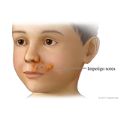Healthwise
Our Health Library information does not replace the advice of a doctor. Please be advised that this information is made available to assist our patients to learn more about their health. Our providers may not see and/or treat all topics found herein.
Topic Contents
Impetigo
Condition Basics
What is impetigo?
Impetigo (say "im-puh-TY-go") is a bacterial skin infection. It causes blisters that can break open, ooze fluid, and form patches of sores. These sores can occur anywhere on the body. Impetigo is one of the most common skin infections in children. It also can occur in adults. It's easily spread.
What causes it?
Impetigo is caused by one of two kinds of bacteria—strep (streptococcus) or staph (staphylococcus). Often these bacteria enter the body when the skin has already been irritated or injured because of other skin problems such as eczema, poison ivy, insect bites, burns, or cuts. Children may get impetigo after they have had a cold or allergies that have made the skin under the nose raw. But impetigo can also develop in completely healthy skin.
What are the symptoms?
Impetigo begins as sores that form small reddish blisters that break open. The sores are typically not painful, but they may be itchy. They may ooze fluid and form patches of crusty sores that may look yellow, gold, or brown. They may also increase in size and number.
How is it diagnosed?
Your doctor can usually diagnose impetigo just by looking at your or your child's skin. Sometimes your doctor will gently remove a small piece of a sore to send to a lab to identify the bacteria. If you or your child has other signs of illness, your doctor may order blood or urine tests.
How is impetigo treated?
Impetigo is treated with antibiotics. For cases of mild impetigo, a doctor will prescribe an antibiotic ointment or cream to put on the sores. For widespread impetigo or cases of impetigo with many blisters, a doctor may also prescribe antibiotic pills.
A child can usually return to school or day care after 24 hours of treatment. If you apply the ointment or take the pills exactly as prescribed, most sores will be completely healed in 1 week.
At home, gently wash the sores with clean water each day. If crusts form, your doctor may advise you to soften or remove the crusts. You can do this by soaking them in warm water and patting them dry. This can help the cream or ointment work better.
How can you prevent it?
If you know someone who has impetigo, try to avoid close contact with that person until the infection has gone away. Do not share towels, sheets, or clothes until the infection is gone. Wash anything that may have touched the infected area.
If you or your child has impetigo, scratching the sores can spread the infection to other areas of your body and to other people. Wash your or your child's hands with soap to help prevent spreading the infection. And cover any blisters that are leaking fluid.
Related Information
Credits
Current as of: December 4, 2024
Author: Ignite Healthwise, LLC Staff
Clinical Review Board
All Ignite Healthwise, LLC education is reviewed by a team that includes physicians, nurses, advanced practitioners, registered dieticians, and other healthcare professionals.
Current as of: December 4, 2024
Author: Ignite Healthwise, LLC Staff
Clinical Review Board
All Ignite Healthwise, LLC education is reviewed by a team that includes physicians, nurses, advanced practitioners, registered dieticians, and other healthcare professionals.
This information does not replace the advice of a doctor. Ignite Healthwise, LLC disclaims any warranty or liability for your use of this information. Your use of this information means that you agree to the Terms of Use and Privacy Policy. Learn how we develop our content.
To learn more about Ignite Healthwise, LLC, visit webmdignite.com.
© 2024-2025 Ignite Healthwise, LLC.




